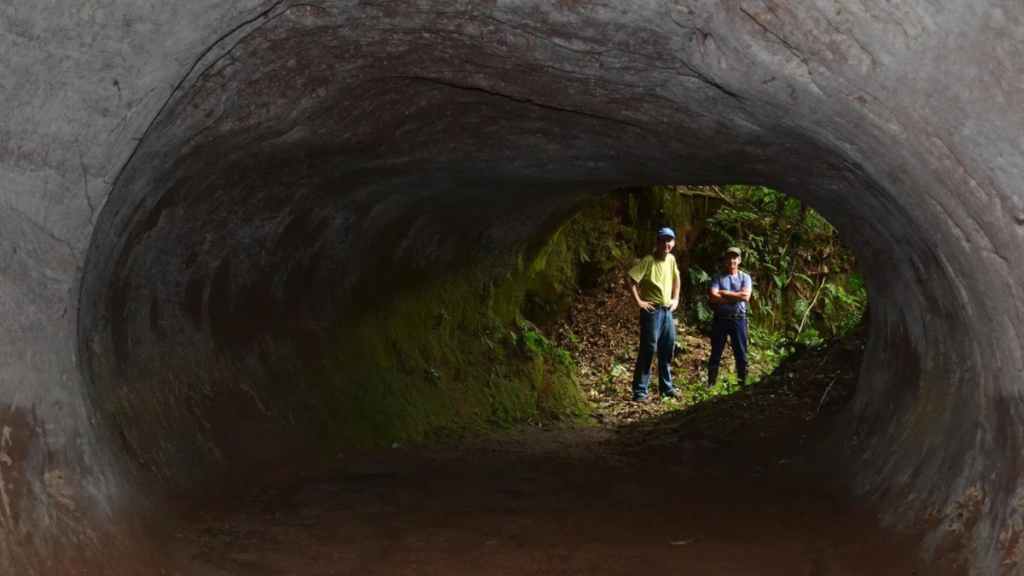In 2009, a local farmer discovered a 2m-high, 2m-wide tunnel in a cornfield in southern Brazil, marking the beginning of an intriguing journey into the world of megafauna paleoburrows. These prehistoric tunnels were discovered by geologist Luiz Carlos Weinschutz, who determined that they were not the work of humans but a testament to the existence of giant ground sloths or giant armadillos dating back over 10,000 years. The southern and south-eastern regions of Brazil boast an unprecedented concentration of megafauna paleoburrows, with over 1,500 recorded in the last 15 years. Local myths and legends surrounding the paleoburrows further deepen the mystery, with some suggesting that the burrows were created by megafauna. The exact purpose of these massive tunnels remains elusive, prompting ongoing research and exploration. The legacy of megafauna remains tangible, as their stories echo through the paleoburrows of Brazil’s south, inviting researchers to delve deeper into the secrets of megafauna and the intricate relationships between these colossal creatures and the land they once called home.
Unveiling the Architects
Scientific investigations led by geologist Luiz Carlos Weinschutz determined that these mysterious tunnels were not the work of humans but rather a testament to the existence of giant ground sloths or giant armadillos dating back over 10,000 years. These prehistoric behemoths, resembling “hamsters the size of elephants,” were formidable in size, some growing up to 4m long and displaying the ability to walk on two legs.
Exploring the Paleoburrows
In 2015, reports surfaced about the discovery of a 100m-long tunnel in the Amazon rainforest, the first of its kind. Years later, I had the opportunity to visit the Southern Canyons Paths Geopark, home to several paleoburrows. Trekking through a forest-clad canyon in Santa Catarina, I encountered a 2m-high tunnel carved into a large, weathered rock. Inside, the dark and cool space bore the marks of sloth claws, resembling an oversized rabbit warren.
Concentration in Brazil’s South
The southern and south-eastern regions of Brazil boast an unprecedented concentration of megafauna paleoburrows, with over 1,500 recorded in the last 15 years. The exact reason for this abundance remains a mystery, with some attributing it to the region’s prominence in paleontological research. However, others propose that geographical evolution and climate variations during the megafauna era might have influenced the unique behavior observed in this area.
Mythical Narratives and Cultural Significance
Local myths and legends surrounding the paleoburrows further deepen the mystery. Indigenous communities, such as the Kaingang people from Rio Grande do Sul, have oral stories that acknowledge the existence of these tunnels. For them, the tales hold cultural significance, intertwining with their history and territory transformations. Some myths even suggest that the burrows were created by megafauna, highlighting the intimate connection between ancient communities and the prehistoric landscape.
The Treasure Hunt and Scientific Validation
Initially, some believed the tunnels to be man-made, leading to treasure hunters scouring the caves for riches supposedly left by Jesuits. The truth, however, lay in the claw marks embedded in the walls, providing conclusive evidence that these tunnels were the result of megafauna activity. Analyzing bones from the region’s animals over the past two million years, scientists ruled out other species, narrowing it down to giant sloths and giant armadillos as the architects.
Unraveling the Purpose
The exact purpose of these massive tunnels remains elusive, prompting ongoing research and exploration. Theories range from providing shelter for nursing young to regulating body temperatures or even hibernation. Each tunnel, possibly crafted over centuries, hints at a communal effort by generations of sloths and armadillos. The strength required to carve through rock and tough sediments, likened to an “absurd strength in their arms,” adds another layer to the mystery.
The Legacy of Megafauna
As I stood in the Museum of Earth Sciences in Rio de Janeiro, holding the claw of a fossilized sloth, the magnitude of these ancient creatures became tangible. While the giant ground sloths and armadillos are long gone, their stories echo through the paleoburrows of Brazil’s south. These tunnels, once believed to hide treasures from civilizations past, now reveal a richer treasure – the enigmatic tales of the megafauna that once shaped the landscape in ways we are only beginning to understand.
Conclusion
the paleoburrows of Brazil stand as silent witnesses to a prehistoric era, inviting researchers to delve deeper into the secrets of megafauna and the intricate relationships between these colossal creatures and the land they once called home.







